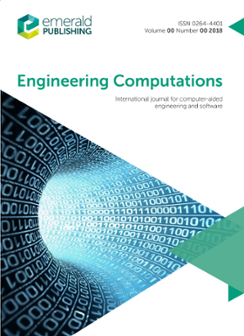Engineering Computations: Volume 7 Issue 1
Strapline:
International journal for computer-aided engineering and softwareTable of contents
Aspects of modelling and computation in the analysis of metal forming
I. St. DoltsinisA synopsis is presented of the numerical finite element methodology currently in use at the Institute for Computer Applications (ICA) for the simulation of industrial forming…
Numerical simulation of thin sheet forming processes by the finite element method
M. Bellet, E. Massoni, J.L. ChenotA numerical model for solving either elastic‐plastic, elastic‐viscoplastic or purely viscoplastic deformation of thin sheets is presented, using a membrane mechanical approach…
Finite element method for gas‐lubricated bearings
Arturo O. Cifuentes, Timothy L. Bock, Robert N. CoppolinoThis paper presents a finite element method for the study of gas‐lubricated bearings. The fluid is assumed to be compressible, and the effect of the molecular mean free path has…
Discrete optimal design of trusses with stress and frequency constraints
K.V. John, C.V. RamakrishnanThe problem of structural optimization of trusses subject to stress and frequency constraints is considered from a practical viewpoint. Assuming that the choice of members has to…
Automatic non‐linear solution with arc length and Newton‐Lanczos methods
M. Papadrakakis, N. NomikosThe application of the preconditioned Lanczos method is proposed for the solution of the linearized equations resulting from a non‐linear solution routine based on Newton methods…
Behaviour of plate elements based on the first‐order shear deformation theory
R.C. Averill, J.N. ReddyA study of the behaviour of shear deformable plate finite elements is carried out to determine why and under what conditions these elements lock, or become overly stiff. A new…
Mixed Eulerian‐Lagrangian finite element analysis of transient flow with a moving boundary
S.K.W. TouThis paper presents a mixed Eulerian and Lagrangian finite element method for solving 2‐D transient flows involving a moving/free boundary. The method combines the simplicity of a…
Simulating curved elements by offsets: rationale and application to shells of revolution
Robert D. CookIn a previous note, curved arch elements were simulated by attaching rigid offsets to nodes of straight elements. The procedure was physically motivated. Here the offsets method…

ISSN:
0264-4401Online date, start – end:
1984Copyright Holder:
Emerald Publishing LimitedOpen Access:
hybridEditor:
- Prof. Chenfeng Li